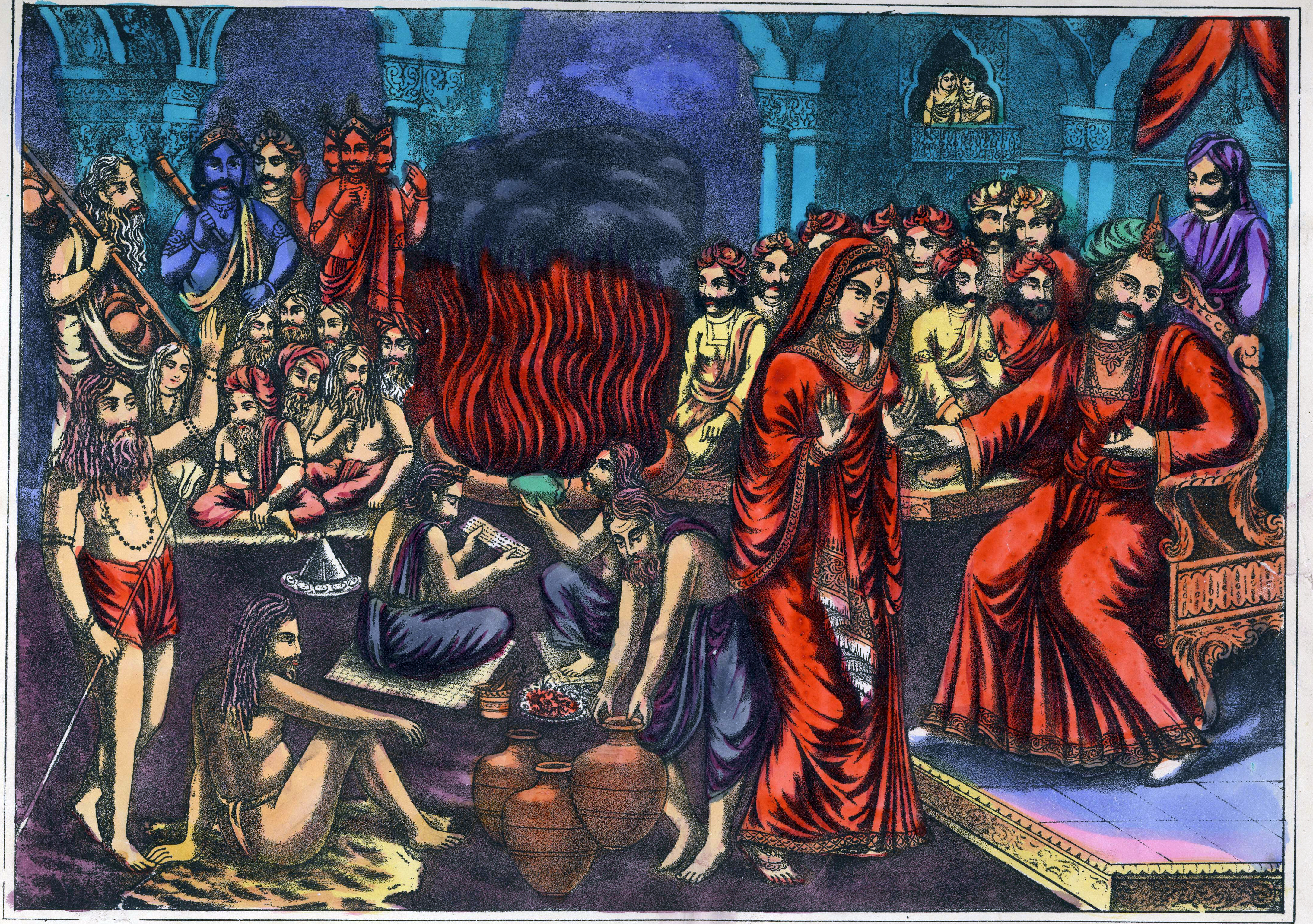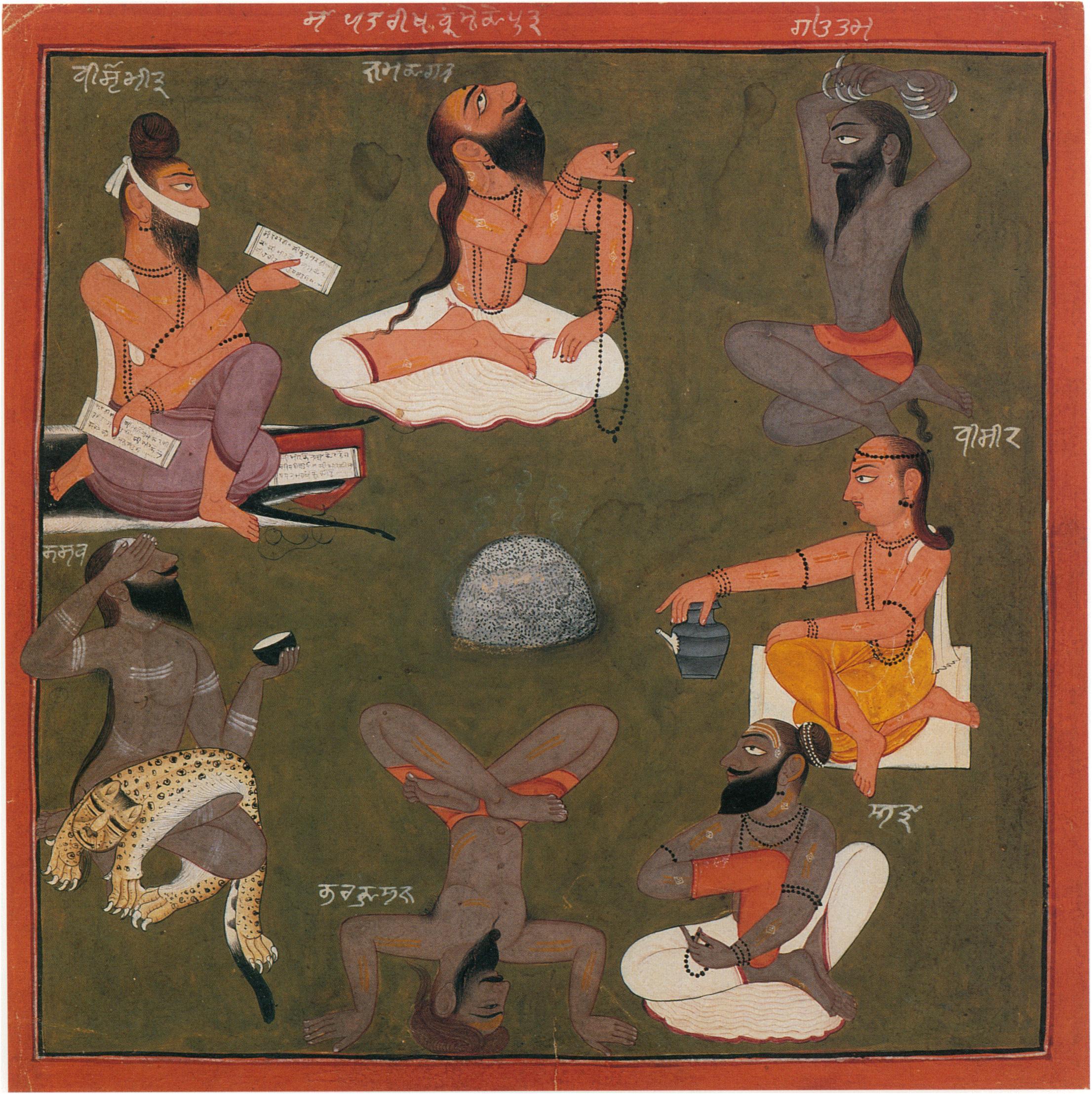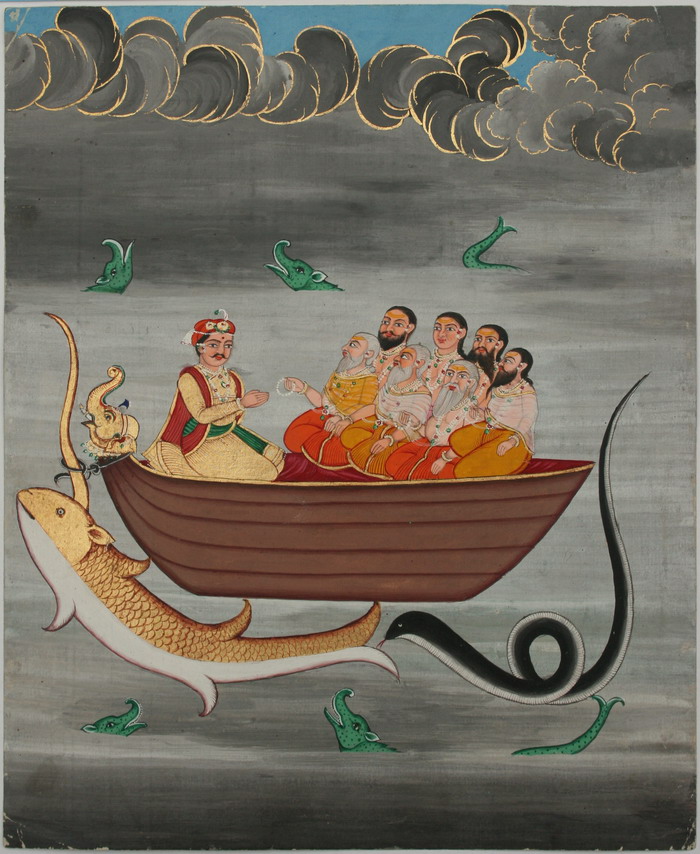|
Kratu
Kratu () is described as one of the manasaputras, the mind-born children of the creator deity, Brahma, in Hinduism. He is also a rishi, who appears in two different ages. He is considered to be one among the seven great sages of the age of the first Manu, the Saptarishis, believed to have originated from the mind of Brahma. In another legend, he is believed to have been born from his father's left eye. Legend In the Svayambhuva Manvantara, Kratu is a Prajapati, a son of Brahma. He is also the son-in-law of Prajapati Kardama. His wife is named Kriya. It is said that he has 60,000 children. Their name is included in the eighth book of the Rigveda. Kratu also has two sisters, Punya and Satyavati. He is also stated to be married to Santati in the Puranas, and the pair has sixty thousand children, called the Balakhilyas, who were each of the size of a thumb, but possessed great mastery over the senses. According to the ''Mahabharata'', while helping the sage Kashyapa with a sa ... [...More Info...] [...Related Items...] OR: [Wikipedia] [Google] [Baidu] |
Prajapati
Prajapati (, ) is a Vedas, Vedic deity of Hinduism. He is later identified with Brahma, the creator god. Prajapati is a form of the creator-god Brahma, but the name is also the name of many different gods, in many Hindu scriptures, ranging from the creator god Brahma to being the same as one of the following deities: Vishvakarma, Agni, Indra, Daksha, and many others, because of the diverse Hindu cosmology. In classical and medieval era literature, Prajapati is the metaphysical concept called Brahman as Prajapati-Brahman, and Brahman is the primordial matter that made Prajapati. Etymology Prajapati (Sanskrit: ) is a compound of "praja" (creation, procreative powers) and "pati" (lord, master). The term means "lord of creatures", or "lord of all born beings". In the later Vedic texts, Prajapati is a distinct Vedic deity, but whose significance diminishes. Later, the term is synonymous with other gods, particularly Brahma. Still later, the term evolves to mean any divine, semi-di ... [...More Info...] [...Related Items...] OR: [Wikipedia] [Google] [Baidu] |
Saptarishi
The Saptarshi ( ) are the seven seers of ancient India who are extolled in the Vedas, and other Hindu literature such as the Skanda Purana. The Vedic Samhitas never enumerate these rishis by name, although later Vedic texts such as the Brahmanas and Upanisads do, so these constellations are easily recognizable. Hindu sacred text An early prototype of the "Saptarishi" concept may stem from the six families associated with the six "Family Books" in the Rigveda Samhita (Mandalas 2–7 in ascending order: Gṛtsamāda, Viśvāmitra, Vāmadeva, Atri, Bharadvaja, Vasiṣṭha). While not a "Family Book", Mandala 8 is mostly attributed to Kaṇva, who could be considered the 7th prototypical Saptarishi. The earliest formal list of the seven rishis is given by Jaiminiya Brahmana 2.218–221: Agastya, Atri, Bhardwaja, Gautama, Jamadagni, Vashistha, and Vishvamitra followed by Brihadaranyaka Upanisad 2.2.6 with a slightly different list: Atri, Bharadvaja, Gautama ... [...More Info...] [...Related Items...] OR: [Wikipedia] [Google] [Baidu] |
Manu (Hinduism)
Manu () is a term found with various meanings in Hinduism. In early texts, it refers to the archetypal man, or the first man ( progenitor of humanity). The Sanskrit term for 'human', मनुष्य (IAST: manuṣya) or मानव (IAST: mānava) means 'of Manu' or 'children of Manu'. In later texts, Manu is the title or name of fourteen rulers of earth, or alternatively as the head of dynasties that begin with each cyclic '' kalpa'' (aeon) when the universe is born anew. The title of the text ''Manusmriti'' uses this term as a prefix, but refers to the first Manu – Svayambhuva, the spiritual son of Brahma. In the Hindu cosmology, each ''kalpa'' consists of fourteen Manvantaras, and each Manvantara is headed by a different Manu. The current universe, is asserted to be ruled by the 7th Manu named Vaivasvata. Vaivasvata was the king of Dravida before the great flood. He was warned of the flood by the Matsya (fish) avatar of Vishnu, and built a boat that carried the Vedas, ... [...More Info...] [...Related Items...] OR: [Wikipedia] [Google] [Baidu] |
Brahma
Brahma (, ) is a Hindu god, referred to as "the Creator" within the Trimurti, the triple deity, trinity of Para Brahman, supreme divinity that includes Vishnu and Shiva.Jan Gonda (1969)The Hindu Trinity, Anthropos, Bd 63/64, H 1/2, pp. 212–226.Jan Gonda (1969)The Hindu Trinity, Anthropos, Bd 63/64, H 1/2, pp. 218–219. He is associated with creation, knowledge, and the ''Vedas''. Brahma is prominently mentioned in Creation myth, creation legends. In some ''Puranas'', he created himself in a golden embryo known as the Hiranyagarbha. Brahma is frequently identified with the Rigvedic deities, Vedic god Prajapati.;David Leeming (2005), The Oxford Companion to World Mythology, Oxford University Press, , page 54, Quote: "Especially in the Vedanta Hindu Philosophy, Brahman is the Absolute. In the Upanishads, Brahman becomes the eternal first cause, present everywhere and nowhere, always and never. Brahman can be incarnated in Brahma, in Vishnu, in Shiva. To put it another way, eve ... [...More Info...] [...Related Items...] OR: [Wikipedia] [Google] [Baidu] |
Daksha
Daksha ( ,) is a Hindu god whose role underwent a significant transformation from Vedic mythology, ''Vedic'' to Itihasa-Purana, ''Itihasa-Puranic'' mythology. In the ''Rigveda'', Daksha is an ''Adityas, aditya'' and is associated with priestly skills. In the epics and Puranas, ''Puranic'' scriptures, he is a Mānasaputra, son of the creator-god Brahma and one of the ''Prajapati#"Prajapati" as a title, Prajapati'', the agents of creation, as well as a divine king-rishi. He is the father of many children, who became the progenitors of various creatures. According to one legend, a resentful Daksha conducted a Daksha yajna, yajna (fire-sacrifice), and deliberately did not invite his youngest daughter Sati (Hindu goddess), Sati and her husband Shiva. In the Linga Purana, for insulting Shiva during this event, which caused Sati to self-immolate in fury, he was beheaded by Virabhadra, an attendant of Shiva. He was later resurrected with the head of a goat. Many ''Puranas'' state that ... [...More Info...] [...Related Items...] OR: [Wikipedia] [Google] [Baidu] |
Daksha Yagna
Daksha ( ,) is a Hindu god whose role underwent a significant transformation from ''Vedic'' to ''Itihasa-Puranic'' mythology. In the ''Rigveda'', Daksha is an ''aditya'' and is associated with priestly skills. In the epics and ''Puranic'' scriptures, he is a son of the creator-god Brahma and one of the ''Prajapati'', the agents of creation, as well as a divine king-rishi. He is the father of many children, who became the progenitors of various creatures. According to one legend, a resentful Daksha conducted a yajna (fire-sacrifice), and deliberately did not invite his youngest daughter Sati and her husband Shiva. In the Linga Purana, for insulting Shiva during this event, which caused Sati to self-immolate in fury, he was beheaded by Virabhadra, an attendant of Shiva. He was later resurrected with the head of a goat. Many ''Puranas'' state that Daksha was reborn to Prachetas in another ''Manvantara'' (age of Manu). His iconography depicts him as a man with a stocky body ... [...More Info...] [...Related Items...] OR: [Wikipedia] [Google] [Baidu] |
Kardama
Kardama () is a character featured in Hindu literature. A son of the creator god Brahma, Kardama is described to be a prajapati, one of the progenitors of creation. After propitiating Vishnu and seeking his counsel for a suitable wife, he marries Devahuti, one of the daughters of the first man, Manu. He becomes the father of nine daughters by her, as well as one son, the sage Kapila. Legend According to the Bhagavata Purana, Brahma is said to have instructed his son Kardama to procreate. Kardama went to the Bindusaras ashrama located at the banks of the river Sarasvati, whereupon he commenced a tapas that lasted ten thousand years to please Vishnu. Propitiated, Vishnu appeared before Kardama, who requested the deity to grant him a wife with whom he could sire children. Vishnu promised him that two days thence, Svayambhu Manu and his wife, Shatarupa, would offer their daughter Devahuti to him for his wife. He further stated that his wife would bear him nine daughters, all of w ... [...More Info...] [...Related Items...] OR: [Wikipedia] [Google] [Baidu] |
Deva (Hinduism)
''Deva'' (, ) means 'shiny', 'exalted', 'heavenly being', 'divine being', 'anything of excellence', and is also one of the Sanskrit terms used to indicate a deity in Hinduism.Monier Monier-Williams, A Sanskrit-English Dictionary” Etymologically and Philologically Arranged to cognate Indo-European Languages, Motilal Banarsidass, page 492 ''Deva'' is a masculine term; the feminine equivalent is ''Devi (Hinduism), Devi''. The word is a cognate with Latin ''deus'' ('god') and Greek Zeus. In the earliest Vedic literature, all supernatural beings are called ''Devas''George Williams (2008), A Handbook of Hindu Mythology, Oxford University Press, , pages 90, 112 and ''Asuras''. The concepts and legends evolved in Indian literature#In archaic Indian languages, ancient Indian literature, and by the late Vedic period, benevolent supernatural beings are referred to as ''Deva-Asuras''. In post-Vedic Hindu texts, such as the Puranas and the Itihasas of Hinduism, the ''Devas'' represent the g ... [...More Info...] [...Related Items...] OR: [Wikipedia] [Google] [Baidu] |
Mānasaputra
Manasaputras (, ) are a class of beings in Hinduism, referring to the 'mind-children' or the 'mind-born' sons of Brahma. In Hinduism, Brahma is believed to have created a number of children from his mind. Sometimes, these children of the mind are stated to be identical to the Prajapatis, the progenitors of all beings in each creation. The Manasaputras are believed to have created the first man, Svayambhuva Manu, and the first woman, Shatarupa, who had five children, who went on to populate the earth. Lists According to the Vishnu Purana, the nine manasaputras of Brahma are: Bhrigu, Pulastya, Pulaha, Kratu, Angiras, Marichi, Daksha, Atri, and Vashistha. These sages are referred to as the Brahmarshis. According to the Bhagavata Purana, some of the manasaputras are: Angiras, Atri, Pulastya, Marichi, Pulaha, Jambavan, Bhrigu, Vashistha, Daksha, Narada, Chitragupta, the Four Kumaras, Himavat, and Shatarupa. See also * Atharvan *Saptarishi *Prajapati *Chitragupta *the Fou ... [...More Info...] [...Related Items...] OR: [Wikipedia] [Google] [Baidu] |
Rishi
In Indian religions, a ''rishi'' ( ) is an accomplished and enlightened person. They find mention in various Vedic texts. Rishis are believed to have composed hymns of the Vedas. The Post-Vedic tradition of Hinduism regards the rishis as "great yogis" or "sages" who after intense meditation (Tapas (Sanskrit), tapas) realized the supreme truth and eternal knowledge, which they composed into hymns.Hartmut Scharfe (2002), Handbook of Oriental Studies, BRILL Academic, , pp. 13–15. The term appears in Pali literature as Ishi; in Buddhism they can be either Buddhas, Pratyekabuddha, Paccekabuddhas, Arhat, Arahats or a Buddhist monasticism, monk of high rank. Etymology According to Indian tradition, the word may be derived from two different meanings of the root 'rsh' (). Sanskrit grammarians derive this word from the second meaning: "to go, to move". V. S. Apte gives this particular meaning and derivation, and Monier-Williams also gives the same, with some qualification. Another ... [...More Info...] [...Related Items...] OR: [Wikipedia] [Google] [Baidu] |
Manvantara
A ''manvantara'', in Hindu cosmology, is a cyclic period of time identifying the duration, reign, or age of a Manu, the progenitor of mankind. In each ''manvantara'', seven Rishis, certain deities, an Indra, a Manu, and kings (sons of Manu) are created and perish. Each ''manvantara'' is distinguished by the Manu who rules/reigns over it, of which we are currently in the seventh ''manvantara'' of fourteen, which is ruled by Vaivasvata Manu.Account of the several Manus and Manwantaras Vishnu Purana, translated by Horace Hayman Wilson, 1840, Book III: Chapter I. p. 259, The first Manu was [...More Info...] [...Related Items...] OR: [Wikipedia] [Google] [Baidu] |







